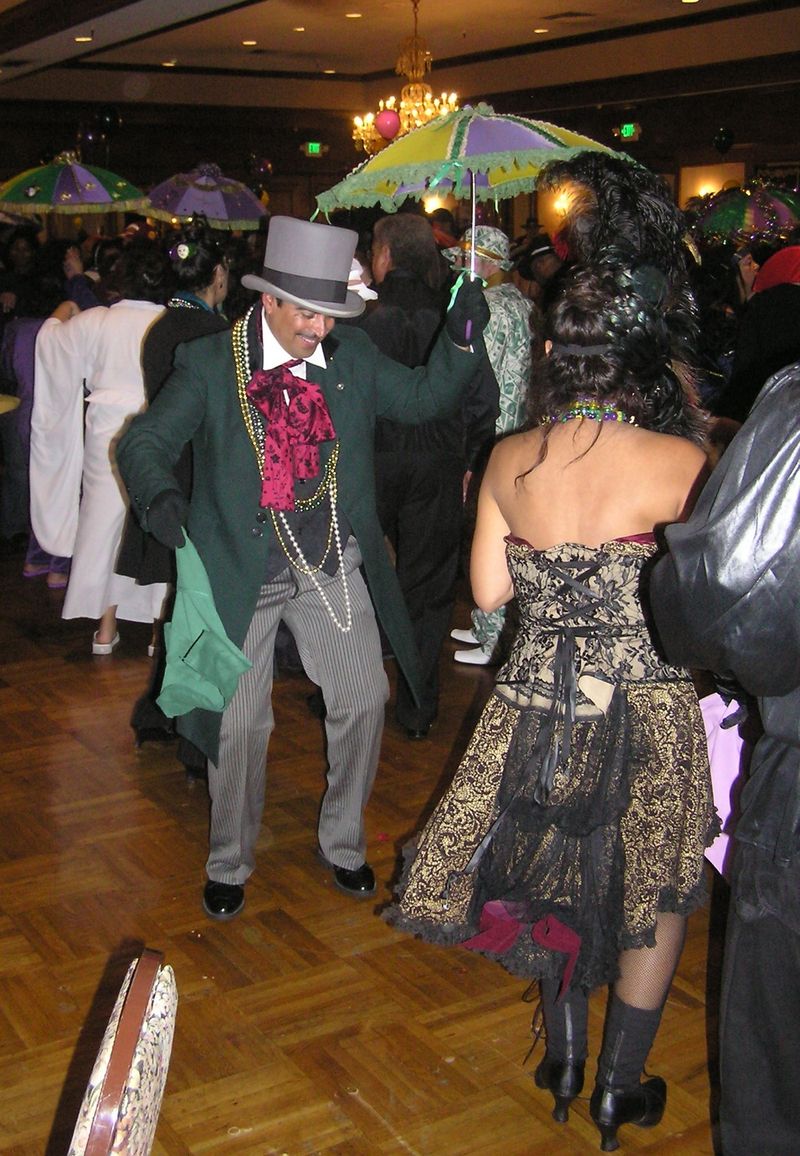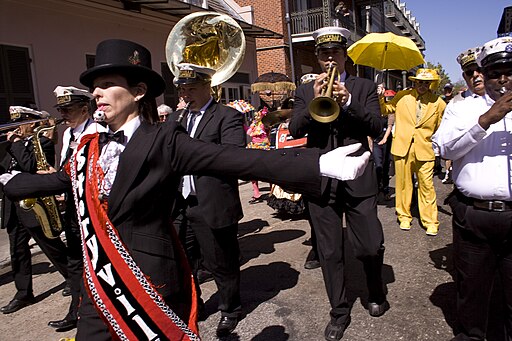The Second Line
 Second line at a Mardi Gras ball in L.A.- photo courtesy of Reiss DuPlessis
Second line at a Mardi Gras ball in L.A.- photo courtesy of Reiss DuPlessis
A couple of years a back – at the LA Helps LA event, my friend and fellow food blogger, Erika Kerekes, turned to me quizzically and asked “what are they doing?”, as a line of guests broke out their handkerchiefs and napkins and started marching around the room to the distinctively New Orleans beat of When the Saints Go Marching In?
They’re “secondlining”, I responded. She still looked stumped. I just smiled.
Whenever a group of New Orleanians is gathered, either in Los Angeles or the Crescent City, they rise to their feet and start waving their handkerchiefs, and often umbrellas, when the funky beat of their hometown wafts over them.
Second lining has its origins (at least in New Orleans) in funeral processions. Brass bands would often march behind funeral processions from the church to the graveyard, playing the solemn strains of a hymn like Just a Closer Walk. Once the burial ceremony had ended, the band would break into much more celebratory music as they turned around and marched back through the streets of the city. Along the way they would pick up people who joined the parade, dancing, waving their handkerchiefs and lifting their umbrellas to the funky beat-hence “the second line”. The beat – and the second line itself – has its roots in Africa (as you can see in the video below of Louis Armstrong’s visit there in 1956), and is heard throughout the New World diaspora, wherever slaves were allowed to play their musical beat- Cuba, Brazil, and New Orleans.
BTW, as for the handkerchiefs and umbrellas, I am sometimes asked how they came to be part of the parade. I can only guess that they are an outgrowth of NOLA’s propensity for a thunderstorm to break out at any time, and to the humid and sweat inducing climate, although there is some evidence that may have begun in Africa, too. I have seen pictures of Louis Armstrong’s visit, where African chiefs broke out their large umbrellas to welcome him in procession. The sequins, fringe and tassels that now decorate the umbrellas are pure New Orleans.
The second line is not really a part of my Creole tradition. My Uncle Reiss wrote a story he shared with me a few years back, when as a child he spied the wondrous sight of a black Baptist funeral procession turning to dancing, as he peered out the doorway of his Aunt Ruth’s uptown grocery store. And I remember on a visit as a child, when my fun-loving Aunt Gloria, demonstrated the second line to her young Los Angeles nieces and nephews. “This is how they be doing it” she called out to us, as she shook her booty and lifted her napkin with all the family egging her on. My youngest brother, Eric, many years later, told her “I’ll always remember you, Aunt Gloria, for teaching me to second line.”
As is true with so much of New Orleans, secondlining has become an integral part of the city’s larger culture now. Second line parades are planned events to which the public is invited, as was yesterday’s, and they are also still spontaneous events that break out as they pass through neighborhoods, as happened last year outside our window while I was staying with my cousin, Linda, in her Gentilly neighborhood, and we ran to the window to see a small parade pass by when we heard the music.
It is a great tragedy that shootings would break out at such joyously emblematic symbols of New Orleans culture. I, along with many others I’m sure, offer prayers for the victims of the shooting*, which include my friend and journalist, Deborah Cotton. Deb fulfilled her longtime dream of moving to New Orleans from Los Angeles just a few months before Katrina. Many of her friends thought she was crazy to return after the storm, but she, as she likes to say, was “New Orleans called”, and did return, going on to become the most prominent chronicler of second line culture. Deb was in surgery yesterday, and has lost a lot of blood, but is reportedly in stable, but guarded, condition now. A fundraiser is now brewing on FB for her. In spite of her injury, I am sure that Deb would agree with the loud and clear statement issued by the Original Big Seven- the Mother’s Day parade band, that the parades must continue, although much more must be done to protect the marchers and onlookers, and to address the violence in this city at large.
Original Big Seven statement:
“Today’s violence is an outrage to what the Original Big 7 and all of New Orleans secondlining culture represents… We are a cross-generational organization, ages 5-70. Our young people grow up in this culture, are fed by it, and feel loved, supported and connected in ways that build real security. That’s crime prevention.”
* As it happens, Eric, along with several of my cousins were also at the parade. They are all unharmed.
Unless otherwise stated, the images are courtesy of WikiCommons









5 Comments
Thank you! This is an awesome description.
May 13, 2013
I remember asking you that very question. Really interesting article!
May 13, 2013
Glad to know the origin of “second lining,” even if this is the *first* I’ve heard of it.
May 13, 2013
I was surprised to not have heard this news before now. I went digging and found that it really isn’t being covered in the US much. Shameful!
And, thanks for the explanation of secondlining. What a wonderful tradition. I hope the community recovers and manages to keep it alive.
May 14, 2013
So sorry about Deb. Man, no event seems to be safe from violence these days. So sad.
I’ve always thought I’d want a New Orleans style funeral when I go. I would rather have people dancing than weeping over me.
May 23, 2013